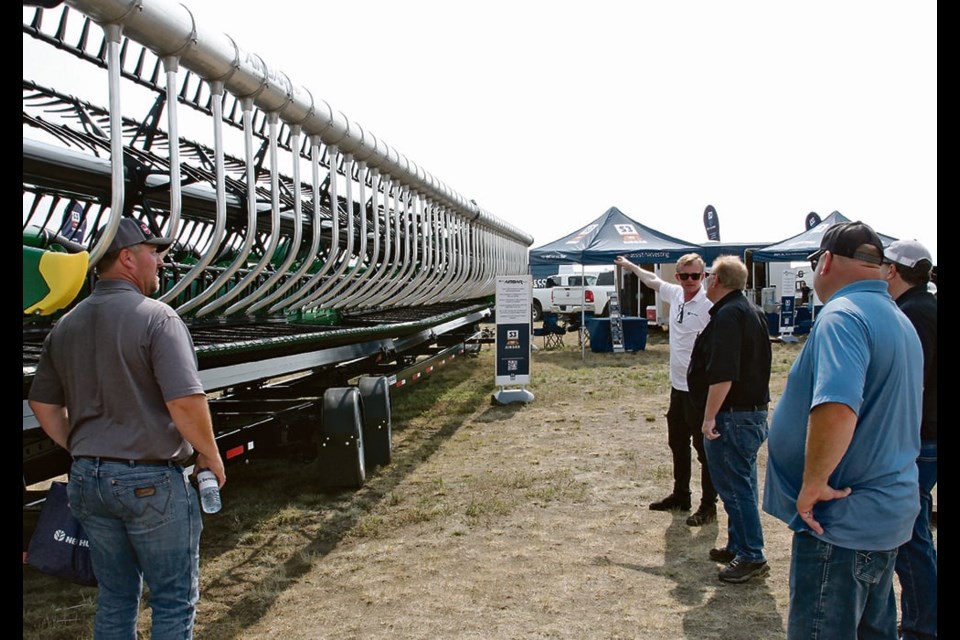WESTERN PRODUCER — A hollow metal tube with regularly spaced long, curved metal tines hangs over the combine header like a weird hybrid of a hay rake and harvester.
Tubes lead behind the header to a powerful blower assembly, hinting at what the S3 AWS Airbar FDX rig is all about: using air to shepherd crop into the combine before it has a chance to drop onto the ground.
Zac Corbin, sales and marketing manager with S3 AWS Airbar, said each of the hollow tines directs a flow of air just behind the knife.
“The air’s stretching that crop up and away, but what’s actually typically clearing off that knife is that kind of negative vacuum effect that’s flowing around the nozzles that’s pulling that crop in,” he said.
Corbin said the natural instinct for producers new to the Airbar is to aim the nozzles at the knife, which is ineffective and kicks up dust and debris.
“We actually want to aim the air about two to five inches behind the knife because that negative air pressure is what pulls the crop in.”
Depending on crop and conditions, this means one to four more bushels per acre in the hopper rather than lost on the dirt. The system is also easily adjustable to accommodate, for example, changing moisture conditions throughout the day.
The demonstration AWS Airbar model at last month’s Ag in Motion farm show was mounted on a 50-foot John Deere draper header, allowing a walkaround tour of its new Airbar Flow Dynamics system. Coupled with an FDX blower that delivers 50 percent more air than the earlier FD model, the setup is designed to maintain efficiency — that is, to not draw more engine horsepower while still enhancing airflow.
While previous AWS Airbar models fed air from one side all the way down the header, this latest twin flow model feeds from the blower from both sides to a split manifold to deliver air separately to each half of the combine header.
While this iteration of the AWS Airbar is brand new — Corbin said it will be available for the next crop year — earlier versions have been on the market for a while. It was initially developed for Ontario producers harvesting navy, pinto and other edible beans.
From its base in Mitchell, Ont., the company’s technology also caught on in Michigan, Minnesota and the Dakotas as producers found the short, bushy crops received gentler handling that helped preserve quality as well as enhancing yield.
The company, now a division of Swift Current-based S3 Group, is looking for opportunities further afield. Corbin said air-assisted harvesting is becoming more popular for soybeans in the United States, but farmers in the western states on the Great Plains are using it for cereals.
“We’re seeing a lot of application in those more western states where it is more arid,” Corbin said. “It’s a very brittle crop where, you know, any contact is going to shell.
“The air, again, it goes back to that softer touch. Get the reel up out of the way, just combing in the top, letting that air fold that crop onto the canvases.”
The AWS Airbar is not suited for all crops, notably matted fields or thick stands of canola. The air tines can easily be flipped out of the way for small sections, or the entire unit can be taken off by removing a few bolts if it won’t be needed for a while.
“Two guys, one on each end of the manifold, lift it off, set in the ditch or put it somewhere out of the field,” Corbin said.
This ease of installation is in partly due to the AWS Airbar’s lightweight aluminum construction, designed for strength without adding unnecessary weight to the combine’s reels.
With this year’s dry conditions, Corbin said there is more interest in air-assisted harvesting to get the most from short, lower-yielding crops. It’s also a modest investment that pays off relatively quickly. The 50-foot demonstration unit, for example, costs about $20,000, a cost quickly paid back with more crop in the hopper.
“When you have those good years, you’re going to get that one to two bushels,” he said.
“Then in the years, they do come unfortunately, Saskatchewan and Western Canada’s has had a couple right now, that’s where it’s really going shine the brightest, to ensure you can make the most out of a harvest, the harvest that you have.”
You can no longer count on social media to deliver important news to you. Keep your news a touch away by bookmarking SASKTODAY.ca's homepage at this link.
Subscribe to SASKTODAY.ca newsletter to get our daily news to your inbox.




